At least Charlie Brown had an excuse: He was given his rock for Christmas. I paid 8 Euros for mine, on the Greek island of Nisyros. My rock is a piece of lava spewed from the earth in one of the most violent eruptions ever. It lies in a simple rough cage of thin metal wires and hangs like a pendant. I bought it from a woman sitting by one of the craters of the massive volcano hat forms the heart of the island, where steam still hisses from the hot, violent earth.
In Your Bucket Because….
- The smaller islands of Greece are a relaxing interesting place to shop, with lots of sightseeing and photo ops.
- There’s tremendous variety here, with souvenirs that reflect history, culture, geography, and craft traditions.
- Good for: Cruisers, history buffs, island-lovers, and shoppers in all budget ranges.
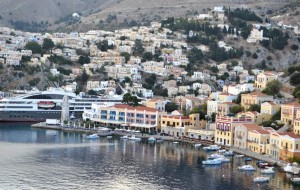
Cruising the islands of the Aegean is one of the classic ways to see Greece. Which islands you visit will largely depend on the size of your cruise ship: I traveled on Compagnie du Ponant’s L”Austral, a 132-cabin ship that could dock at smaller islands. Larger ships that carry a thousand (or more) passengers are likely to dock in the larger ports of Crete, Santorini, Mykinos, and Rhodes. Another option for independent travelers with more time to spend is to take advantage of the system of ferries that runs between the islands: You’ll have your choice of destinations, and can spend as much time sightseeing, sun-bathing, and shopping as you like.
Shopping Specialties on the Greek Islands
Shopping is a pleasure in the smaller islands: There’s something peaceful and relaxing — two feelings I don’t normally associate with shopping — about walking aimlessly from shop to shop down windy alley-ways that pass as streets, past carefully whitewashed houses with flaming pink bougainvilleas set against the almost vibrating Mediterranean sky. Even the most touristed islands still seem to retain their character, even if the merchandise inside the quaint little storefronts sells beach toys to tourists.
Except in Rhodes: There is nothing relaxing about shopping in its bustling market: This is a town with a cosmopolitan feel. And with its ancient stone walls and forbidding medieval-styled fortress, Rhodes looks more like the kind of place a armor-covered knight would pick for a jousting contest: There’s nary a whitewashed villa in sight.
While most islands carry some of the standard issue tourist items during the high season (with busy Rhodes and super-chic Mykonos carrying every type of T-shirt and refrigerator magnet known to Homo sapiens touristus), most islands also have little quirks and discoveries of their own. Here are some I stumbled across:
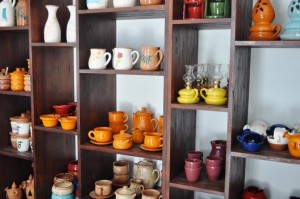
Pottery: The seldom-visited island of Sifnos was known for its pottery in ancient times, and the tradition survives today, with local artisans taking a modern aesthetic to the ancient craft. Prices on Sifnos are low.
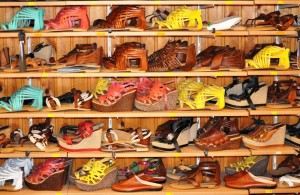
Religious icons: Icons (paintings of the saints) are part of the Orthodox Christian tradition, and are available as either mass-produced souvenirs for the tourist market or from individual craftsmen. Prices vary accordingly. The island of Patmos, where St. John is reputed to have written Revelations in a cave, has a wide selection of icons. The markets in Rhodes are more cacophonous and touristy, but you’ll find icons there, as well.
Leather work: Leatherwork is a Greek specialty. You’ll fine plenty in the Plaka in Athens, but if you happen to stop in at the island of Symi, I’ll recommend the leather shop on the main street steps away from the cruise ship dock. The designs are created by the proprietor, so you’re getting a true Greek original. You’ll find good prices on belts and purses, but if something is beyond your budget, ask: A polite request for a discount might yield a lower price.
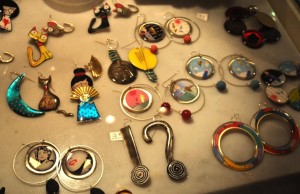
Jewelry: Some of the Greek Islands have lovely upscale shops with hand-crafted original jewelry made by local artisans. I particularly enjoyed browsing in Santorini. Rhodes also has a plethora of jewelry shops, although not of the handmade quirky artisanale kind. I also saw some interesting shops in some of the villages on Sifnos, a lovely, small island that gets few cruise ships because of the size of its harbor.
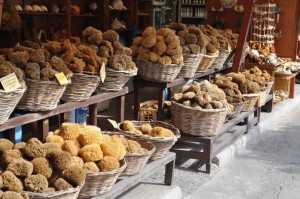
Sponges: Natural sponges taken from the sea are available all over Greece. Sponges are a specialty on the island of Karpathos (you’ll also see them on Symi), and make an unusual gift, especially when combined with olive oil soap (popular on Crete).
Mastic: Mastic (think mastication) is a tree resin found only on one part of the island of Chios. To me, it tastes like pine tar (yuck), but it’s used in chewing gum (the word masticate) and as an ingredient in the original Turkish delight candy. I guess this one is an acquired taste: I happened to be in Chios during the mastic harvesting season, and though locals willingly handed some over for me to taste, I have to say that the bitter gum did not make it to the top of my “must repeat in the future list.”
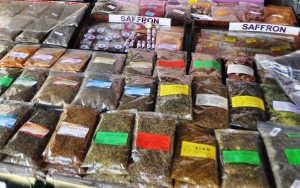
Spices: I couldn’t walk past the spice shop on the main drag on the island of Symi without stopping to take a picture, and once I caught a whiff of the spices — neatly labeled “for feta,” “for Greek salad,” “for grilled lamb,” “for fish” — resistance was futile. I brought home several large bags for a few euros.
Practicalities
- I know that summer is the high season in Greece, but for the life of me I don’t know why: Not being a lover of hot weather, I cringe at the prospect of 90 and 100 degree days, sea breezes notwithstanding. I most recently traveled in Greece in late September, and the (admittedly unseasonably warm) 80 and 90 degree weather was more than hot enough, the sea sill warm enough for bathing, the shops less crowded, and many souvenirs available at end-of-season prices. May and June also seem like saner months. Locals declare the winters to be bone-chilling, although as someone who lives in New England, I’m taking a “believe it when I see it” approach to that.
- If you need to buy souvenirs for a whole lot of people back home, Rhodes has a bustling main stream with a bazaar feel, with every kind of souvenir imaginable. Myknonos is also heavily touristed, with more stuff to buy than you’ll have time to even look at.
- Much of the merchandise on offer in the larger tourist areas s is also available in Athens in the Plaka. The unique one-of-a-kind pottery and jewelry found on some of the smaller islands may not be as easy to find elsewhere. Shopping in the smaller islands is a bit more personal and laid back — Except for Rhodes, which is not in the least laid back. Or Mykonos, for that matter.
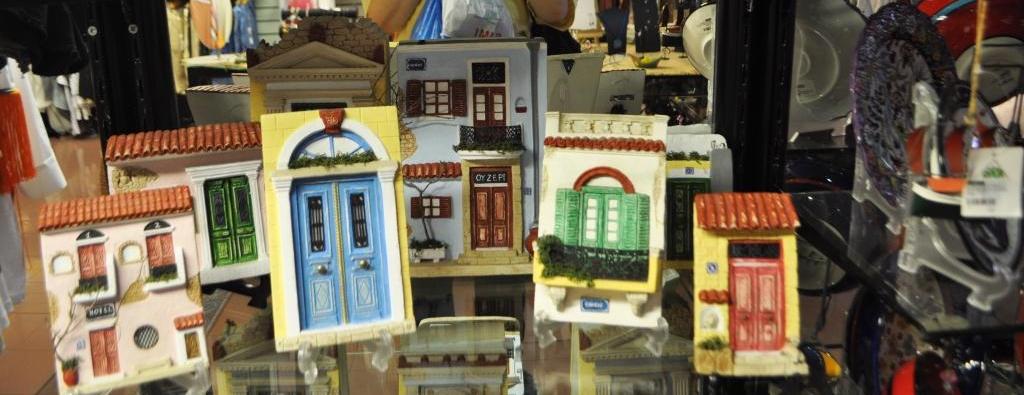
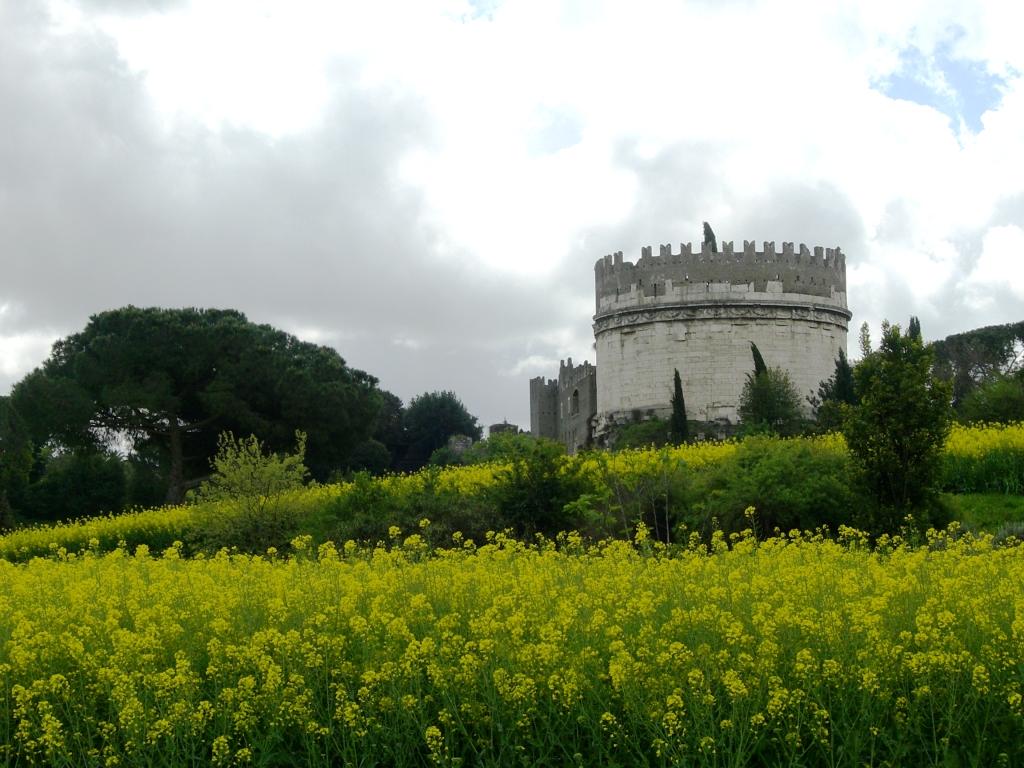
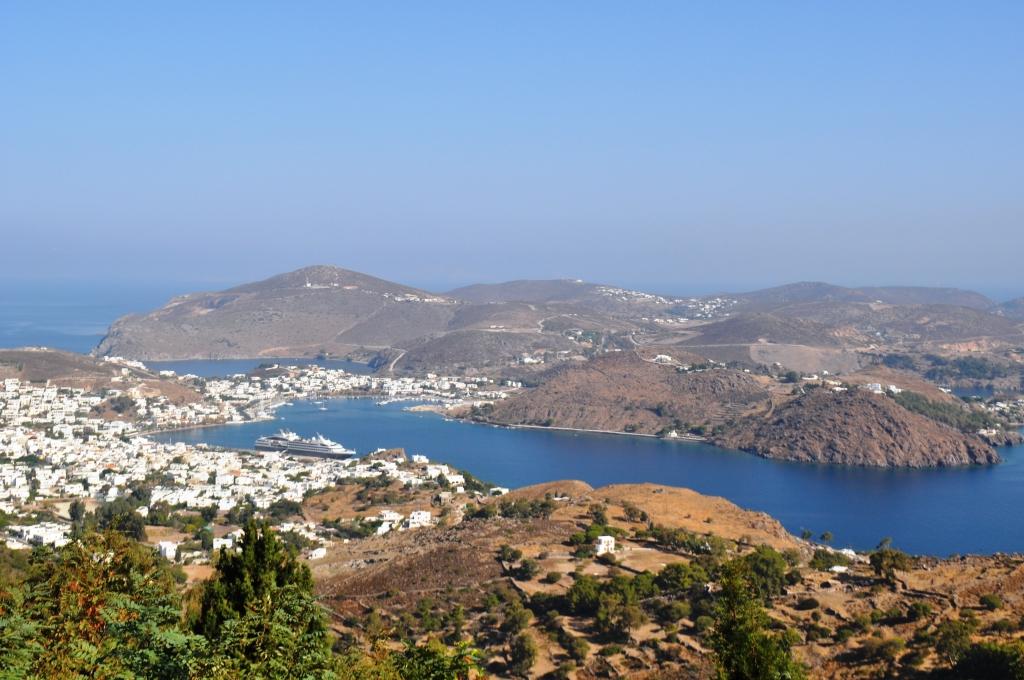
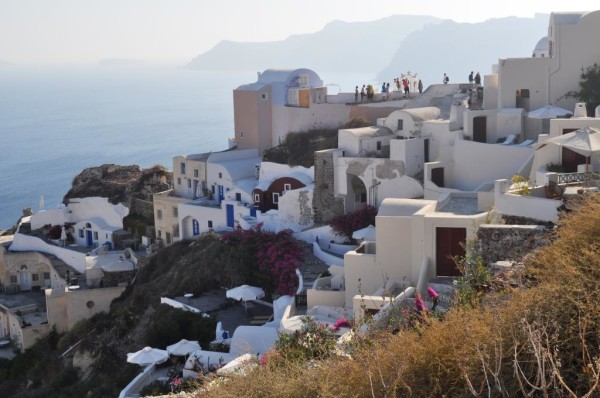
Souvenirs from Greece, I understand you did not like the Mastixa (gum) from the beautiful island of Chios, even though it is delicious and is used for cooking, baking, beauty products, as well as medicine , and many other uses.
Mastixa is from Chios and Chios only the “Greek delights” are of Greek origin and not Turkish like your article indicated.